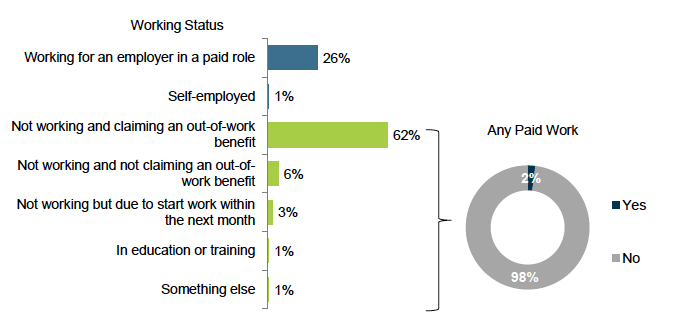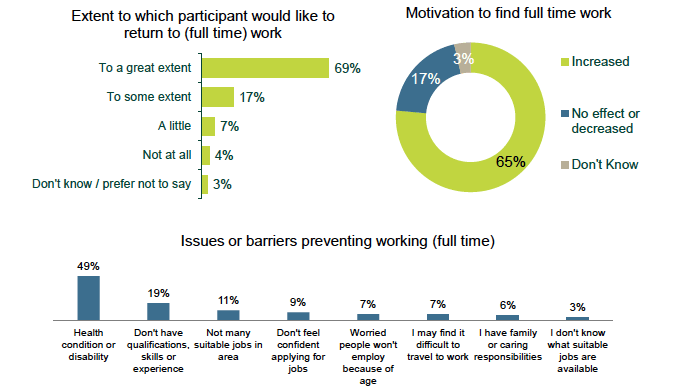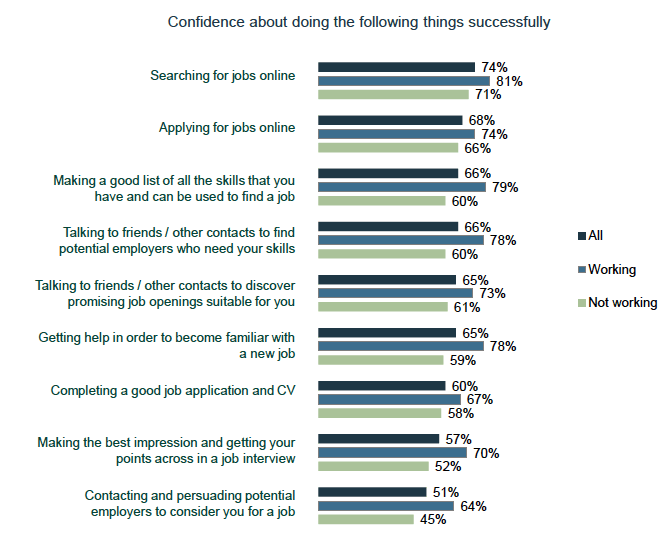Fair Start Scotland evaluation report 2: participant phone survey - November 2019
Part of a series on the evaluation of Fair Start Scotland employability services. It presents more detailed findings from a representative telephone survey of FSS participants and explores their experiences in the first year of service delivery (Apr 18 to Mar 19).
6. Return to Work
In the first half of this chapter we look at levels of employment amongst participants, whether taking part in the Fair Start Scotland service made participants more motivated to take steps to find full time work and what barriers participants still had about this. The second half of the chapter examines the skills that participants had for finding work, using the Job Search Self Efficacy Index.
6.1 Employment status
At the point of the Wave 1 interview (in June 2019), 29% of respondents were working[5] and 67% were not in work. Almost two fifths (38%) of respondents had not worked in the last 5 years. A greater proportion of younger respondents were in work than older respondents (40% of those aged 16-24 compared with 25% of those 35-49 and 24% of those 50 and over).
Those who had worked in the last 5 years were also more likely to be working currently (39%) than those who had not worked at any time in the last 5 years (11%). Those in Lot 3, Tayside, were also more likely to be working (41%) than the other lots.
Working status

Source: A1: Which of the following best describes what you are doing at the moment? Base: All respondents (1005) A1a: Did you do any paid work in the seven days prior to the interview? Base: Any not employed or self employed (733)
Level of education was also correlated with working status. Those with Highers or equivalent (40%) and those with a degree level qualification or above (35%) were more likely to be in work than those with either no education (21%) or National 1-5 or equivalent (26%).
Of those in work, half (49%) were in full-time employment (30 or more hours per week). Two-fifths (38%) worked between 16 29 hours per week, whilst 12% worked fewer than 16 hours per week.
Figure 5.2 Weekly working hours amongst those in work

Source: A3: How many hours a week do you usually work? All in work (286)
As might be expected women were more likely than men to be in part-time work, 16 to 29 hours a week (16% vs 9%), reflecting national employment patterns[6].
Those that had worked in the last 5 years were also more likely to be in full-time employment (as opposed to part time) (21%) than those who had not worked in the last 5 years (4%).
In addition to being more likely to be in any type of employment, those in Tayside (Lot 3, 24%) were more likely to be in full time employment than those in other areas.
6.2 Views on returning to work
The vast majority of participants receiving pre-employment support felt that they wanted to return to (full time) employment in the future, with seven in ten (69%) stating that they wanted to return "to a great extent" and a further 17% "to some extent". A small proportion (4%) did not want to return to work; this was more common amongst older participants (aged 50+, 8%) and those whose health limited their day-to-day activities (6%).
There were higher levels of desire to return to work amongst men than women (72% and 64% wanted to return "to a great extent", respectively), and amongst those qualified to degree level of above (83%). There was some indication that those who have been out of work for longer periods felt less strongly about returning to work, with 77% of those who have worked in the last five years wanting to return to a great extent compared with 61% of those who have been unemployed for five years or more.
Participation in the Fair Start Scotland service had a positive effect on motivation to find employment for two-thirds (65%) of participants, with 41% reporting that their motivation to find work had increased a lot. However, a fifth (21%) of participants receiving pre-employment support felt that their motivation levels had not changed, and one in ten (10%) reported a decrease in motivation.
The service appears to be less likely to have a positive impact on the motivation levels of those with a long-term health condition than other participants; half (51%) of those with no health condition said that their motivation had increased a lot from when they began receiving support from Fair Start Scotland, compared with only 36% of those whose health limits their day-to-day activities. A quarter (25%) of those with no health condition compared with 35% of those whose activity is limited by their healthy stated that their motivation levels had stayed the same or decreased.
Figure 5.3 Views on returning to work

Source: E2: To what extent would you like to return to (full time) work in the future? E5: What would you say are the main issues or barriers preventing you from working (full time)? E9: To what extent would you say your motivation to find (full time) work has increased or decreased from when you began receiving support from the FSS service? Base: All who work fewer than 16 hours per week (754)
Indeed, health proved to be the issue most commonly mentioned when those in pre-employment support were asked about the barriers they face returning to work, with half (49%) stating that this was one of the main issues they faced. This factor was more commonly mentioned by women (56%) and older respondents (50+, 58%).
A lack of skills, qualifications or experience was the second most frequently mentioned issue that participants felt was preventing them from finding work (19%). Men (22%), younger people (16-34; 23%), and BAME individuals (39%) were particularly likely to cite this as a barrier to employment.
A range of other concerns were mentioned, some of which were particularly felt by subgroups of respondents, for example:
- Family or caring responsibilities were more commonly mentioned by women than men (11% compared with 3%);
- One in five (19%) of those aged 50 or over were concerned that they would not be offered employment due to their age
- A quarter (26%) of those in the Highlands and Islands (Lot 8) felt there were not many suitable jobs in their local area (11% overall).
6.3 Job search skills
Respondents completed a nine-item measure of the strength of an individual's belief that they have the skills to undertake a range of job search tasks, known as the Job Search Self Efficacy (JSSE) Index. The original JSSE Index was developed at the University of Michigan (Vinokur et al., 1995) and contained six items. This was modified by R. Birkin and M. Meehan in 2014 with the addition of three items to address using IT for job search and job applications, and also getting help to become familiar with a new job.
Over all respondents, there were variations in the levels of confidence felt about specific job search tasks, which ranged from most feeling confident (74%) about searching for jobs online through to a half (51%) who felt confident about contacting and persuading potential employers to consider them for a job.
The average score JSSE index score across the nine statement iterations revealed some groups with lower confidence in their ability to find a job, compared with the mean (3.8), namely:
- Those without formal educational qualifications (mean score 3.4)
- Participants who had not worked in the five years prior to joining the Fair Start Scotland service (3.7)
- Those whose day-to-day activities were limited by a health condition (3.7)
- Participants from Forth Valley (Lot 4) (3.5).
Those aged 16-34, conversely, demonstrated greater confidence regarding these job search skills, with a mean score of 4.0 across all statements.
As expected, participants in work at the point of the Wave 1 interview were more likely to feel confident about each measure of job searching ability, as shown below.
Figure 5.4 Job Search Self Efficacy Measures

Source: F2: How confident do you feel about doing the following things successfully Base: All respondents (1,005)
There were a handful of significant differences by area in terms of participant confidence about individual job search skills. For example:
- Those in Tayside (Lot 3), were considerably more likely to feel confident about making their best impression and getting their points across in the job interview (67%) compared with the overall average (57%)
- Participants in Forth Valley (Lot 4) were less confident about their ability to search for jobs online (64% compared with 74% overall) and to apply for jobs online (55% compared with 68%). They also felt less sure of their ability to get help in order to become familiar with a new job (50% compared with 65%), or about talking to friends or other contacts to discover job openings (55% vs 65% overall).
- Respondents in the South West (Lot 6) were more confident about their ability to get help with a new job (74% vs 65% on average).
Contact
Email: kirstie.corbett@gov.scot
There is a problem
Thanks for your feedback